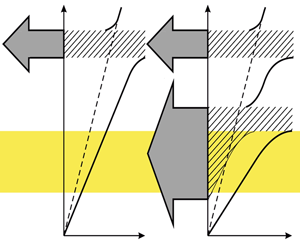Microwave parameters of components of shielding composites. Part 1: Mechanisms of microwave reflection
DOI:
https://doi.org/10.3103/S0735272722120020Abstract
Polymer, rubber and other dielectric composites filled with powder additives that absorb microwaves are widely applied in radio-electronics for reducing the reflection from metallic surfaces and suppression of electromagnetic noise. The efficiency analysis of absorbing microwave composites involves the need to determine the fundamental reasons that describe the reflection and absorption of electromagnetic (EM) radiation in materials, which are the components of shielding composite. This study consists of two parts. The first considers mechanisms of EM wave reflection from dielectrics, semiconductors, magnetics, and metals. The second part is devoted to EM wave absorption in these materials with due regard for dimensional effects. The impact of different components on microwave parameters of composites has been also analyzed.
References
- M. T. Ali, Y. R. Muhsen, R. F. Chisab, S. N. Abed, “Evaluation study of radio frequency radiation effects from cell phone towers on human health,” Radioelectron. Commun. Syst., vol. 64, no. 3, pp. 155–164, 2021, doi: https://doi.org/10.3103/S0735272721030055.
- F. Kremer, A. Schönhals, Eds., Broadband Dielectric Spectroscopy. Berlin, Heidelberg: Springer Berlin Heidelberg, 2003, doi: https://doi.org/10.1007/978-3-642-56120-7.
- M. T. Sebastian, Dielectric Materials for Wireless Communication. Amsterdam: Elsevier, 2008, doi: https://doi.org/10.1016/B978-0-08-045330-9.X0001-5.
- J. Kruželák, A. Kvasničáková, K. Hložeková, I. Hudec, “Progress in polymers and polymer composites used as efficient materials for EMI shielding,” Nanoscale Adv., vol. 3, no. 1, pp. 123–172, 2021, doi: https://doi.org/10.1039/D0NA00760A.
- A. Choudhary, S. Pal, G. Sarkhel, “Broadband millimeter-wave absorbers: a review,” Int. J. Microw. Wirel. Technol., vol. 15, no. 2, pp. 347–363, 2023, doi: https://doi.org/10.1017/S1759078722000162.
- X. Zeng, X. Cheng, R. Yu, G. D. Stucky, “Electromagnetic microwave absorption theory and recent achievements in microwave absorbers,” Carbon, vol. 168, pp. 606–623, 2020, doi: https://doi.org/10.1016/j.carbon.2020.07.028.
- D. D. Tatarchuk, Y. M. Poplavko, V. Kazmirenko, O. V. Borisov, Y. V. Didenko, “Composites based on dielectric materials for microwave engineering,” Radioelectron. Commun. Syst., vol. 59, no. 2, pp. 74–82, 2016, doi: https://doi.org/10.3103/S0735272716020047.
- Y. Poplavko, Dielectric Spectroscopy of Electronic Materials: Applied Physics of Dielectrics. Woodhead Publishing, 2021, uri: https://www.elsevier.com/books/dielectric-spectroscopy-of-electronic-materials/poplavko/978-0-12-823518-8.
- B. Vagananthan, Y. S. Lee, K. Y. You, H. S. Gan, F. H. Wee, “Investigate the effect of dielectric properties on microwave absorption of pyramidal microwave absorber,” J. Microwaves, Optoelectron. Electromagn. Appl., vol. 21, no. 2, pp. 328–336, 2022, doi: https://doi.org/10.1590/2179-10742022v21i2257631.
- M. Perez-Escribano, E. Marquez-Segura, “Parameters characterization of dielectric materials samples in microwave and millimeter-wave bands,” IEEE Trans. Microw. Theory Tech., vol. 69, no. 3, pp. 1723–1732, 2021, doi: https://doi.org/10.1109/TMTT.2020.3045211.
- M. J. Weber, Handbook of Optical Materials. Boca Raton: CRC Press, 2003.


